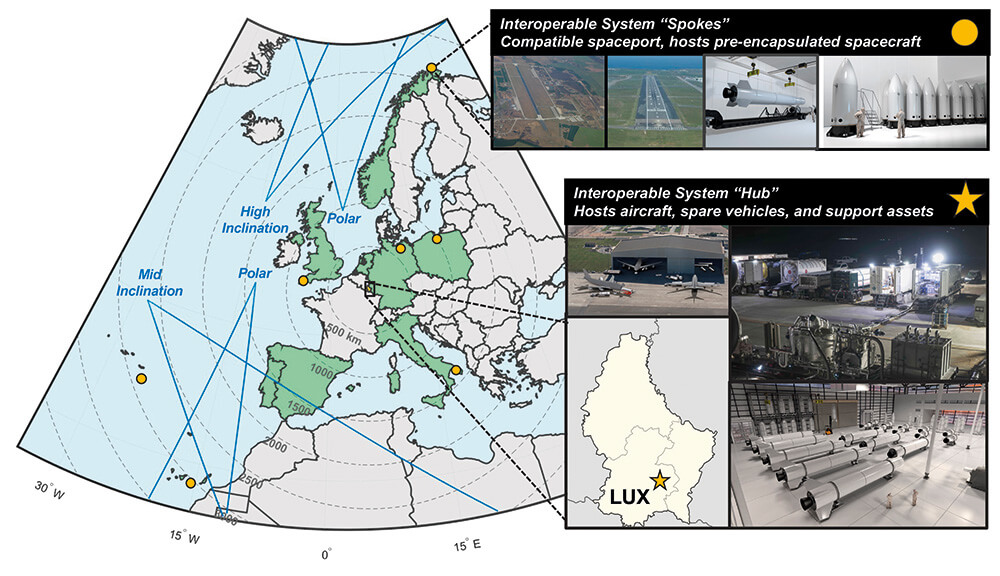Introduction
With NATO facing a contested space domain, members have begun exploring responsive space capabilities that enable rapid deployment of space assets providing critical Data, Products, and Services (DPS). As explained by US Army General James Dickinson of the US Space Command (USSPACECOM), ‘During conflict, the ability to rapidly reconstitute degraded systems within hours forces adversaries to rethink the economic benefit of attacking on-orbit assets. This capability allows USSPACECOM to provide warfighters continuous access to space-based capabilities for multi-domain overmatch.’1
The opportunity now exists to develop a NATO-specific responsive space architecture.2 While several allies are deploying their own satellites and developing sovereign spaceports, the procedures and mechanisms for jointly executing responsive space operations do not yet exist. As responsive space activities are complex, a common set of operational processes is critically needed to achieve NATO interoperability.
This paper describes a framework for NATO members to field an interoperable responsive space capability. Through a scenario depicting the deployment of a responsive launch system to an allied spaceport, it highlights acquisition and infrastructure considerations for conducting joint responsive operations. It provides readers insight into how to direct allied responsive space investments so that duplicative effort is prevented, maximizing resources for the benefit of the alliance.
Coordinating Responsive Space Investments & Program Management
While the advent of small satellite platforms are enabling NATO members to deploy sovereign space capabilities, the unique challenges associated with acquiring and deploying space capabilities remain. It is impractical for every NATO member to finance and develop their own end-to-end space capabilities; multilateral collaboration is needed.
However, the commoditization of microsatellite platforms and emergence of layered constellations provide a foundation for joint space missions. This includes horizontal responsive space systems – in which different components, such as the satellite, encapsulated payloads, launch vehicle, carrier aircraft, and mission operations, can be shared across different allies. The ability to segment a responsive space system enables allies to coordinate investments by which each country owns or funds a specific element (e.g., one country funds the ground support equipment and another country manages the carrier aircraft). Distributing a responsive space architecture across multiple allies is more cost-effective than having each member own and operate their own standalone systems.
To build this interoperable, disaggregated responsive space architecture, NATO members will require a common program management framework. The challenges associated with space acquisition reinforce the need for allies to coordinate their investment and program management activities. A central program management and acquisition mechanism is needed to coordinate allied investments in responsive space capabilities to minimize these risks.
In building out a multilateral responsive space capability, allies can leverage the NATO Support and Procurement Agency (NSPA) to centralize the program management. Unlike other multilateral responsive space initiatives that are limited to research and development activities (e.g., the Responsive Space Capabilities MOU), an NSPA Support Partnership can facilitate the acquisition, management, and sustainment of a responsive space system. The forthcoming NSPA Support Partnership agreement on commercial satellite communications (SATCOM) provides a precedent for how NSPA can support space projects; the NSPA Multinational Multi-Role Tanker and Transport Fleet provides a template for the procurement of shared complex systems.3,4 An NSPA Responsive Space Support Partnership would allow allies to focus on space requirements development, mission design, and space operations, allowing NSPA to become an allied centre for expertise in space program and acquisition management.
Demonstrating Multilateral Responsive Space Interoperability with a Mission Scenario
While the previous section described a concept for how allies could coordinate the investment of an allied responsive space system, NATO’s employment of an interoperable responsive space capability is best demonstrated through a case study describing member states’ responses during a scenario. This case study is predicated on future NATO investments into a responsive space architecture and the following assumptions:
- A NATO responsive space framework, as described in ‘Leveraging Responsive Space and Rapid Reconstitution’ is established.5
- Responsive horizontal launch infrastructure, launch vehicles, and a shared carrier aircraft have been designated across compatible airports within example allied states of the US, the UK, Germany, Luxembourg, the Netherlands, Norway, Poland, Italy, Portugal, and Spain.
- A space cargo and mission logistics hub is established in the central European theatre, hosting the single carrier aircraft, mobile ground support equipment, and/or air-launched rocket vehicles.
- Pre-selected and spacecraft payload processing facilities are maintained in Italy, Germany, and/or the UK.
- A unified responsive space program management mechanism forms the foundation of a NATO-allied interoperable responsive launch framework.
A European network of airports compatible with horizontal launch already exists.6 Establishing a grouping of facilities that can support an allied responsive launch network is a matter of technical and regulatory evaluation. Most allies possess one or more airports capable of handling such activities, which operate under shared Eurozone airspaces and control authority. The case study assumes at least one launch-compatible spaceport per member state mentioned above.
A cost-effective interoperable responsive launch framework can be maintained with a minimized quantity of mobile launch assets. Rather than utilizing several launchpads with separate at-the-ready launch vehicles and ground support equipment, a single or few sets of launch assets are shared across different compatible spaceports. Leveraging those mobile assets to reduce the barriers for launch execution across those spaceports is key.
Case Study
This case study begins with an exemplary definition of NATO’s responsive horizontal launch architecture. Given its central geographic location and air freight activity, Luxembourg is notionally chosen as a cargo and mission logistics hub to host mobile launch assets, including a carrier aircraft and supporting mobile ground support equipment. Attached to the central hub are the spokes of the allied interoperability model. Each of the other allies hosting a compatible spaceport are these spokes.
Resilience of satellite constellations is enabled by the guarantee of readily replacing on-orbit assets that are disabled. NATO allies can achieve this by locally storing ground spares of their spacecraft, which are pre-encapsulated and adhere to a launch standard already established as part of the horizontal launch service. The spacecraft would be pre-configured for certain Intelligence, Surveillance and Reconnaissance (ISR), Space Domain Awareness, or SATCOM missions leveraging commercially developed payloads. Security needs can be assured given that the encapsulated modules remain in-country until launch. In-country payload processing infrastructure can be maintained to the scale required by the desiring member state for added flexibility. The infrastructure lifecycle management would be managed by NSPA via the terms of a Support Partnership involving the participating allies.
The need for responsive space arises when a critical on-orbit asset is disrupted or lost. In this scenario, a sun-synchronous (SSO) Earth observation ISR satellite used by allies to observe territory in Eastern Europe ceases responding with the asset feared lost. Heightened tensions alongside loss of the asset are cause for concern given adversarial military operations in the region. Replacement of the satellite becomes an urgent requirement with a radar satellite identified to penetrate cloud coverage and provide ground moving target indicator data over contested areas.
Mobilization of the responsive space architecture begins with the activation of horizontal launch assets – the carrier aircraft and its mobile ground support equipment – in Luxembourg. Pre-encapsulated satellites that are compatible to replace the missing asset are already stored near their payload processing facilities in the UK, as well as Germany and Italy. Of the compatible spaceports that are present, Germany is chosen to host the launch given its proximity to the ground support equipment and carrier aircraft positioned in Luxembourg. The carrier aircraft is flown to the German airbase to begin the launch campaign alongside an operations squadron of allied personnel trained in launch operations.
Pre-designed shipping logistics are employed, where support equipment and launch vehicle are air-shipped from Luxembourg to the waiting carrier aircraft and pre-encapsulated payload in Germany. Integration of the system on a pre-conceived but austere operations pad occurs within a 24-hour window, followed by a launch operation where the vehicle is fueled and readied for takeoff. Mission Control activities are managed by a remote central command centre, possibly facilitated by existing NATO Allied Air Command facilities.
Launch activities after takeoff follow a design scheme that is agnostic to the originating spaceport in Germany. Aside from the departure flight path of the aircraft, the launch vehicle release site and trajectory would be pre-designed as part of a Eurozone orbital access plan. This modularity in mission design continues the theme of interoperability, where shared azimuth corridors can permit a wide degree of inclination access to any NATO member state. Examples of these azimuth corridors are shown in Figure 1, indicating that a wide degree of access to orbits inclined between 45 degrees and SSO may be possible with a horizontal launch system.
In the case of this scenario, a mission racetrack and launch point in the North Sea is most appropriate for rapid launch into SSO with shared telemetry assets sourced from the UK and Norway. The carrier aircraft would reach this site within an hour of takeoff, where the launch vehicle would release and carry the spacecraft into a precise replacement orbit for the lost asset within approximately an hour thereafter. Mission operations could then seamlessly pass from the launch command centre to spacecraft operators. Once deployed, the spacecraft would leverage advanced automation and asynchronous system evaluations to be rapidly commissioned, making it available to tasking requests from allied Space Support Coordination Elements.
Despite having sourced the carrier aircraft, support equipment, rocket, and payload from separate locations, a responsive and interoperable architecture enabled integration and launch of the united system within 24 to 48 hours. The carrier aircraft, supporting ground assets, and operations team would return to their original stand-down locations across the member states, or to their roles as part of commercial European launch operations.

Similar operations could have also occurred in other member states with waiting pre-encapsulated payloads. While Germany was chosen due to proximity and convenience, other states such as those highlighted in Figure 1 could likewise host launch operations with access to the very same airspaces and orbital access corridors. This flexibility is of most value in scenarios when shared launch assets aren’t necessarily headquartered in a single location. The hallmark of interoperability is that there is no limit to the variety and scale of NATO launch operations made possible with mobile horizontal launch infrastructure.
Conclusion: Leveraging Responsive Space Operations to Enable Resilient NATO Space Capabilities
This scenario exemplifies how NATO members can coordinate their investments and leverage the flexibility of horizontal launch systems to conduct joint responsive space missions. The prospect of joint NATO space missions is necessary to preserve space-based DPS for NATO members; as explained by General Raymond, Chief of Space Operations of the US Space Force, ‘I really would like to get these partnership[s] to be more than just data sharing partnerships and really move towards mission sharing.’7 In particular, a responsive space demonstration would create an opportunity for NATO allies to practice and exercise the multilateral CONOPs described in the aforementioned scenario.
Ultimately, a disaggregated allied responsive space capability will not only transform the way military space missions are performed, but also enable a new level of resilience for NATO space-based DPS in an era of near-peer space threats. With responsive space, allies can quickly replace degraded allied satellites as well as deploy new space assets in an unpredictable, unwarned manner. Private investment in dual-use satellites and horizontal launch systems creates favourable economic conditions for NATO members to fold this into an allied responsive space capability. By leveraging a disaggregated responsive launch architecture built upon shared allied contributions, NATO members will have tremendous flexibility in conducting joint space missions.











